


We did not try the hop-on-hop-off bus in Barcelona. It was chargeable and would go to a fixed number of places, some of which did not interest us. So, we preferred walking at our own pace and visiting what fancied us. We used public transport as and when required. We stayed at a hotel around the Estació d’Autobusos Barcelona Nord (bus station) so it was convenient for us to get around the city on foot.
There are plenty of things to see in Barcelona, Spain. When you walk around the city, you will see that most of the structures are thoughtfully and creatively designed; each construction unique in its own way. But while a few ‘top sights’ mentioned online are not worth planning a visit at all, according to us, there are some interesting places to visit in Barcelona that won’t disappoint you!



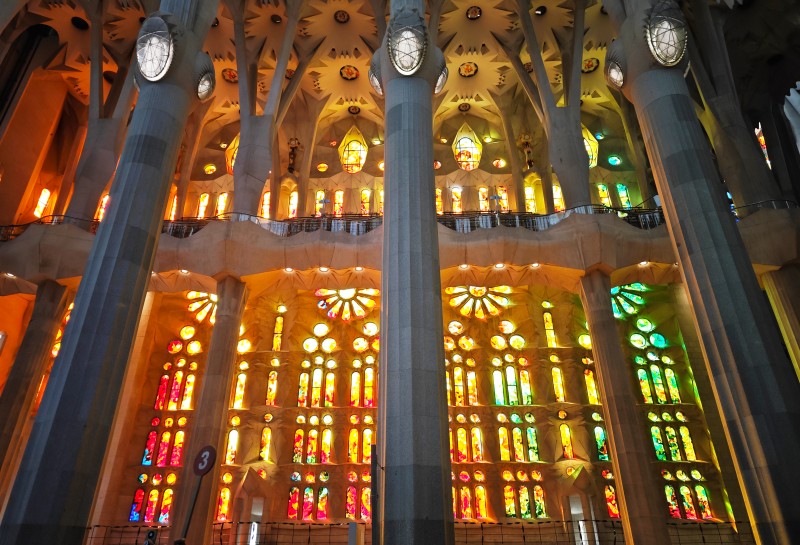

Out of the interesting places to visit in Barcelona, the Sagrada Família has been number 1 on our list since we first visited it in 2017 with kids and will be number 1 until we find something more breathtakingly stunning than it. We found it more striking than the beautiful Kremlin in Moscow, too.
Though not completed, the Sagrada Família has been declared a UNESCO World Heritage Site under ‘Works of Antoni Gaudi’. Two months ago, we visited the Sagrada Familia again and, this time, explored it as thoroughly as possible, without kids.
You can buy your tickets here.
This newly consecrated Church has been under construction since 1882. It is an ‘Antoni Gaudi’ creation unique from his other buildings and a Church distinct from the other churches around Spain. Every part of the Sagrada Familia has a story to it. We took the English guide option and got to know a lot about the idea behind the sculptures, designs and the Church as a whole. Some interesting facts are:
-Gaudi believed that man’s creation couldn’t be higher than God’s creation so the tallest tower of the Sagrada Familia (Tower of Jesus Christ) is only 172.5 metres high; shorter than Montjuic which stands at 173 metres.
-As Gaudi was a devotee of Mother Mary, he dedicated one tower, with a star on top of it, to her.
-Gaudi carefully plaster-moulded dead animals, living people and tools as models before the final sculptures were created.
-Margarita, a donkey, was alive during the plaster-moulding for the ‘Flight to Egypt’ scene.
-The fruits on the steeples represent the fruits of good deeds.
-The pillars at the entrance are each built on a sea turtle and a land turtle because the Sagrada Familia (which is in the centre of Barcelona) is equidistant from the sea and the mountains on either side.
-The four towers dedicated to the Evangelists (Mathew, Mark, Luke, John) were only completed in November 2023.
-The three facades at the entrance represent the three Christian virtues; Hope (on the left), Faith (on the right) and Charity (in the middle).
-Gaudi spent 43 years of his life dedicated to building the Sagrada Familia with barely any clothing as he had no money to buy new garments.
-The pillars inside the Church were meant to imitate trees.
-The elevator in one of the towers was installed by Gaudi after taking inspiration from Barcelona’s first elevator in the Columbus Monument in 1888.
-Gaudi built a school next to the Sagrada Familia because he felt that educating the workers’ children was also important. His school did not follow the traditional education but the new teaching methods of Maria Montessori.
While the steeples and most of the structure are scheduled to be completed by 2026 (Gaudi’s 100th death anniversary), the whole Basilica will be completed only in another 10 years. Phew! That’s a long wait!
The Gaudi Square or Plaça de Gaudí can be visited before or after your visit to the Sagrada Familia as this is just a small, square green park opposite the Church.






For a ticket worth Euro 14/-, you get to see the interiors, the choir area, the chapter house, the museum, the rooftop and take a virtual tour. Plus, an English audio guide is also included.
The interiors are mesmerizing. Each and every corner is wonderfully designed. Inside the Cathedral, about 70 out of 140 saints are sculpted, each in a gated cubicle. The rest of the saints are around the Cathedral.
The choir area was amazing. The organ was under repair so we could hear a lot of notes being tuned. The items in the chapter house were very impressive but no photography was allowed there. From the rooftop, you could see Montjuic, Sagrada Familia and Torre Glories. The virtual reality show was also good! In the cloister around the pond, very interestingly, you will always find 13 geese that represent the age at which Saint Eulalia (patron Saint of Barcelona) died.
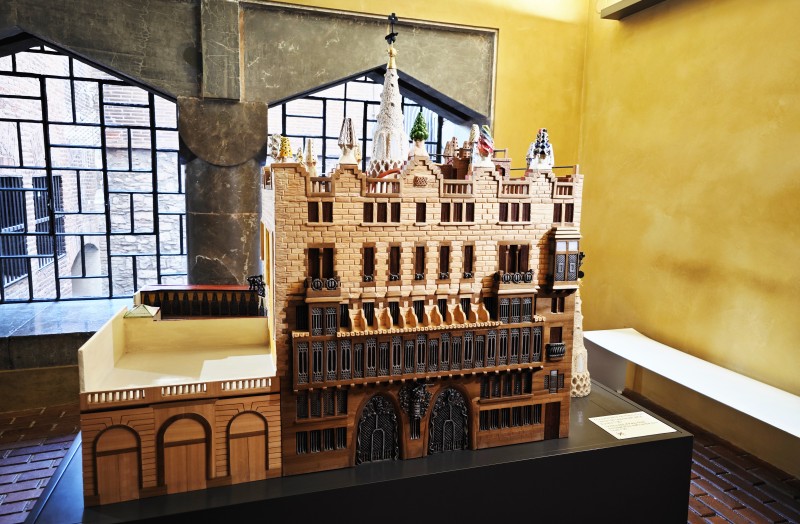






Palau Güell was designed by Antoni Gaudi as his first major work in Barcelona for his patron, industrial tycoon Eusebi Güell. Gaudi met Güell in 1878 and was commissioned by him in 1885. Ultimately, Palau Güell opened in 1888 with a lot of pending work still being carried out after that. It was declared a UNESCO World Heritage Site in 1984.
This palace looked quite simple from the outside because the entrance was all grey, including its oval gates. Inside, we missed the numbering for some reason and landed at the top in 2 minutes. So, we started exploring from the roof down to section 1. It was amazing to see the ancient furniture so well-maintained. The basement which was meant to park horse carriages was well-ventilated with natural air, so it didn’t feel stuffy down there. Everything, like the Church organ built into the palace, the huge bay windows in the rooms, the sinuous architecture on the roof with around twenty chimneys designed with broken glass, etc. was quite impressive.
You can buy your ticket at the gate or book in advance here. If you’re taking the audio guide (which you will), be ready for the most uncomfortable headphones you would have ever come across. This part was not interesting, but the beauty of the palace was worth the discomfort after all.
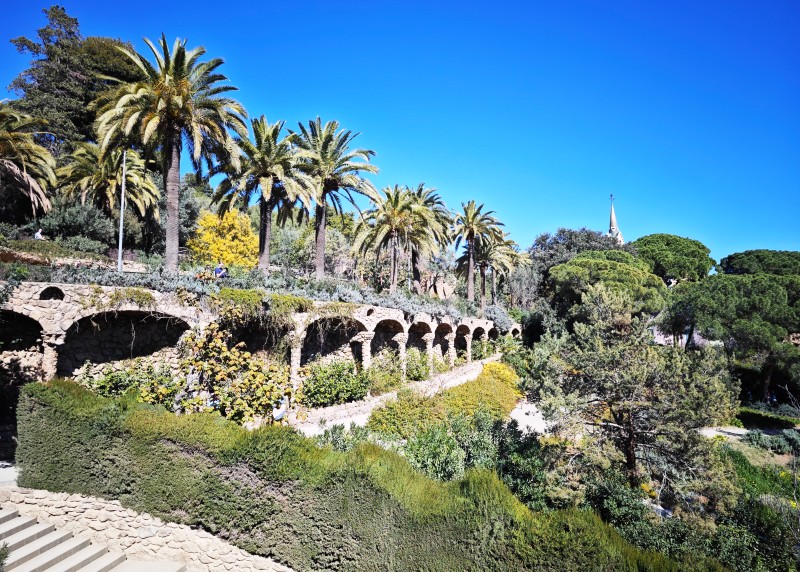




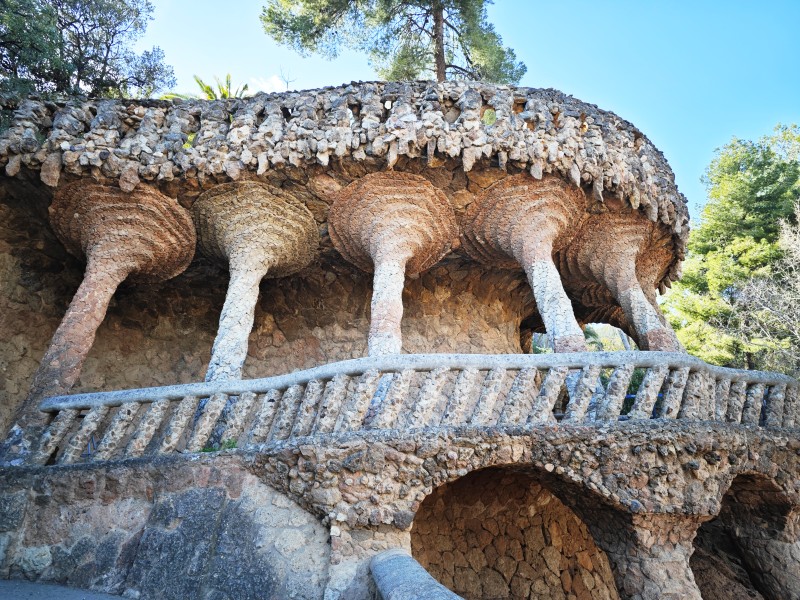


Fascinatingly, from 1900 to 1914, this huge park across 17 hectares, designed by architect Antoni Gaudi, was initially planned as a housing development for the elite residents of Barcelona. By 1903, the two pavilions at the entrance (the Porter’s lodge), the main staircase, the exterior fence, viaducts, part of the walkways, and the drainage system, were all completed. The Hypostyle Hall or Hall of a Hundred Columns was finished in 1907 but with around 86 columns only. Work in the park was abandoned by 1914, due to the lack of buyers.
Then, in 1918, the owner Eusebi Güell died and his heirs sold the estate, in 1922, to the City Council. Due to several construction difficulties, the space was finally opened as a municipal park in 1926 and declared by UNESCO as a World Heritage Site in 1984.
Apparently, Barcelona is a city that is home to more than 400 dragons (legend related to St. George, the patron Saint of Catalonia), therefore, a statue of an 8-foot-long salamander lies at the entrance of Park Güell (which is actually the exit now). This is the most-photographed dragon in Barcelona due to Gaudi’s unique trencadis design. Besides the two pavilions at the entrance, you can visit the Gaudi House Museum, inside the park, which was Gaudi’s home between 1906 and 1925. These were the only three houses built inside Park Güell.
Since October 2013, due to the influx of visitors, the tickets to the monumental zone are now chargeable.

Besides the ones mentioned above, Antoni Gaudi designed many intricate structures around Spain. The interiors of many were also designed by him. Some of them in Barcelona are worth visiting:
Casa Vicens Gaudí – This is considered to be Gaudí’s first major project. He drew up the initial plans between 1878 and 1880 but Casa Vincens was built only between 1883 and 1885. When we were in Barcelona, it was closed to the public due to an event, so, in case you’re visiting, check online to see if it’s open and then buy your ticket here. You can admire the stunning interiors of the Palm Room, the Arabian Hall, the Owner’s Bedroom and the rooftop.
Casa Batlló – Gaudi redesigned a previously built house in 1904 and this bluish structure became one of his masterpieces. The interiors have been refurbished several times since then but they are still worth visiting. You can buy a ticket to see it here.
La Pedrera or Casa Milà – Casa Milà was built between 1906 and 1912 and happens to be the last private residence that Gaudi designed. The unique balcony design is the most interesting. La Pedrera is also a Foundation. You can visit the building or admire it virtually here.

If you’re interested in steaks, you can visit Carnal Steak House, a 10-minute walk from Casa Milà. Read my review here.




Besides the Cathedral of Barcelona, the Gothic Quarter is well known for its plentiful eateries, restaurants and bars amid beautiful mediaeval buildings. The Gothic quarter runs along the lines of the busy La Rambla street filled with vendors, painted characters and souvenir shops. Towards the seaside, you will find the Columbus Monument. You can spend your whole day in the Gothic Quarter and visit the places mentioned below:
–Saint James’s Square – a garden square where you can hang out.
–Muhba Temple – there are only three pillars from ancient times. Some boards tell you the history of the Roman Temple.
–Aquàrium Barcelona – made up of 35 aquariums with around 11,000 animals of more than 400 species. It’s a great place to visit with kids, too.
–Basílica de Santa Maria del Pi – or Cathedral ‘St. Mary of the Pine’, is a Gothic Church built in the 15th century.
–Museu Frederic Marès – an art and sculpture museum with a collection of thousands of items by sculptor Frederic Marès.
–Plaça del Rei – or King’s Square, is a historical landmark from the Barcino times.
We found a Japanese restaurant, called Gaijin, in one of the narrow lanes of the Gothic Quarter. The sashimi there was yum and the server was courteous and patiently explained what each item on the Spanish/Catalan menu contained. It was a nice experience. See my review here.
The Basilica of Santa Maria del Mar, ‘Saint Mary of the Sea’, is a 14th-century Gothic-style Church a little outside the Gothic quarter, in case you’d like to explore it.

La Roca Village, a paradise for shopaholics, houses the famous outlet mall of Barcelona. Located 36 km from the Sagrada Família, La Roca Village has around 150 designer fashion brands like Mango, Diesel, Burberry, Armani, Calvin Klein, Gucci, Michael Kors, Prada, Versace and plenty more. It also has a lot of eateries, restrooms and other stores allowing one to have a smooth shopping experience.


After you’ve been to the most interesting places to visit in Barcelona, you can check out a few others if you have time. You can visit Barceloneta Beach which is equipped with sports facilities, play areas for children and several eateries. You can also visit the mid-19th-century Ciutadella Park on the way to the beach. The lovely green park is 10 minutes from the Gothic Quarter and houses the regional Parliament, lounging areas and a huge monumental water fountain with different types of birds freely prancing around in the pond.

Not very well maintained but Parc del Laberint d’Horta is fascinating with its 18th-century neoclassical garden and 19th-century romantic garden. It is located around 5 km from Park Güell (30 minutes by public transport) and has a beautiful hedge maze designed in the centre. Kids and adults can have some fun trying to find the centre of the hedge maze.
If you walk around Barcelona, you will find a tall bullet-shaped building called Torre Glòries, which is an office building designed by a French architect inspired by Gaudi.
To conclude, despite the beauty of Barcelona, the locals warn you about the pickpockets in the city (though I was blessed not to encounter any, yet). So, make sure your bag is as close to you as possible and your mobile phone is in your pocket. Maybe you can keep some cash in your pocket, too, just in case. You don’t have to panic at all times, but as a precaution, try and avoid getting into narrow lonely lanes (which I think one should do in any new city you visit).
Nevertheless, be alert, be aware of your surroundings and enjoy your time in Barcelona!
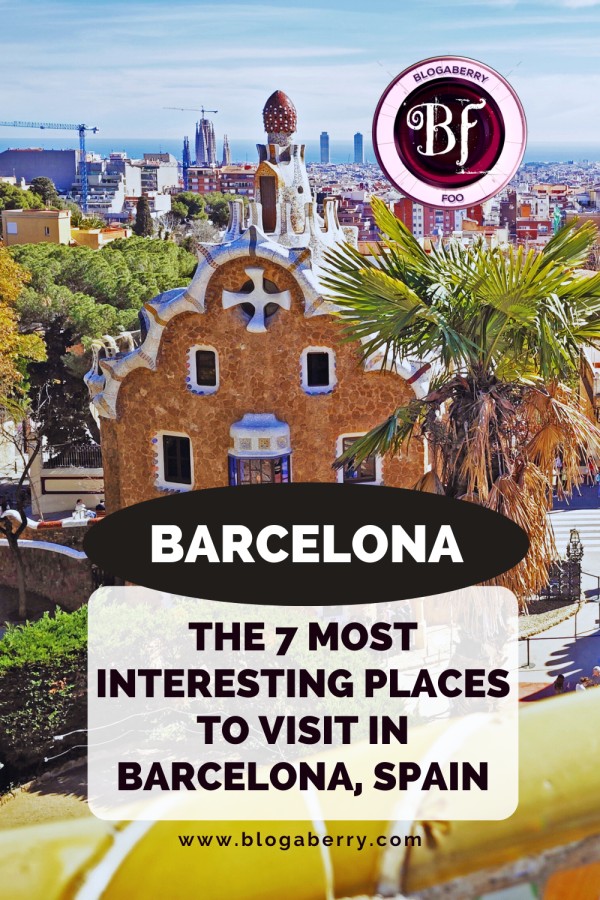
This blog post is part of the blog challenge ‘Blogaberry Dazzle’
hosted by Cindy D’Silva and Noor Anand Chawla
in collaboration with Zariya Healings.
You are invited to the Inlinkz link party!
Click here to enter
35 Comments
Exploring Barcelona on foot allows you to truly immerse yourself in the city’s unique architecture and vibrant culture. Public transport is an excellent alternative to see hidden gems and avoid tourist traps. I look forward to your recommendations on the most interesting places to visit!
Your article “Interesting Places to Visit in Barcelona, Spain” vividly captures the city’s vibrant culture and must-see attractions, making it an essential guide for travellers. The rich descriptions and insider tips provide a captivating and informative journey through Barcelona’s diverse offerings.
Barcelona is in bucket-list since i watched ZNMD.
Though most of the itineraries shows the beach side of activities, your article helps to know more about historical and cultural monuments there. Would love to try Sashimi place.
Spain is a lovely country with so much of heritage. It has been on our bucket list for some time and we hope to go there sometime soon. Barcelona is of course a gem, and our favourite place is the La Sagrada Familia.
what an interesting place and i loved your selection of 7 places to visit . It is quite interesting architecturally and how seeped this city seems to be in its culture.
Barcelona looks like such a lovely place. That Cathedral and its architecture is so stunning. As I was reading your tour, I got completely absorbed in your description of the places and the cuisine of Barcelona. Glad you brought us this post.
To be honest, I was intrigued by the beautiful Barcelona architecture after I read Dan Brown’s Origin. I had googled every place he mentioned and La Sagrada Familia and Casa Vicens have been on my must-see list ever since. Now I have added more places to it!
Wow! What a wonderful experience, Cindy. I could keep gazing at these pics forever!! the interiors of the churches are so beautiful, but what caught my eye was the loo…gosh! Itna sundar! 🙂
Yeah! Janaki! Truly amazing!
Spain has been on my list for a long time. Your guidance is very detailed and definitely worth saving. I would love to travel slowly in Spain and would spend at least 5 days in Barcelona to cherish all these designs by Gaudi. I loved the pictures and food suggestions. I would love to try tapas here, for sure.
Thank you for sharing such a detailed list. They surely sound like interesting places. I enjoyed reading the stories too. I agree with you about the loo. Very colorful.
The place looks astounding and extremely beautiful. I loved the varied pictures and could easily understand the bit history of the place. I admire your deep research about the place and guiding how the place became a World Heritage for all. Great job!
The most appreciating element of this blog are the pictures that I am sure you clicked and each one of them marvelously captured. Thank you for sharing the outstanding and worth visiting spots of Barcelona. Will surely refer when I plan for the Barcelona Trip.
Beautiful pics, Cindy. The last two ones from Park Güell practically look like a gingerbread house. Would love to visit Barcelona someday. Filing your post for future reference. Thanks for the virtual tour series.
Thanks, Ritu!
Wow, this post brings back memories of my own trip to Barcelona! The Sagrada Familia left me in awe. Your tips on the Gothic Quarter are spot on. Can’t wait to visit again and explore Park Güell as you suggested!
I’m sorry but the pictures are so beautiful that I was lost in going through them and read the article afterwards. Cindy, visiting Barcelona is my son’s biggest dream. Your article has made it my dream too!;)
It’s lovely, Aditi! The best in Europe for me, architecturally at least!
Wow! Thank you for bringing us on your tour to Barcelona. This is one of the cities we opt-out from our Europe tour last 2019 and instead visited Italy instead. I love your photos as it really showed us how the place looked like. Spain would still be in my list of places to visit and hope to go to in our next Europe tour.
Wow which part of Italy did you visit?
Wow Cindy! The monuments are absolutely stunning, both inside and out, with such fascinating histories. You clicked beautifully. I’m planning a trip there soon, and thes3 recommendations are indeed helpful. I’m especially excited to check out Park Güell and La Sagrada Familia. Your tips make everything sound so accessible and exciting. Saving this post now. Can’t wait to explore Barcelona with your recommendations in mind.
All the best, Anjali!
I would surely love to visit Barcelona. I love the vibe of its vibrant energy and rich culture. The pictures you have shared are truely amazing. I can imagine walking around the colorful streets, trying out different foods, and just soaking up the atmosphere. Barcelona, I can’t wait to visit you!
Barcelona is one of my favourite cities. I had gone with my son and family in 2016. There was a huge musical fountain we went to. The beach had so many Indians selling drinks and beach rugs. La Rambla is a bustling place, full of life, and again so many Indians. We had gone on a ropeway ride if I remember. I love the colours, the vibe and the people. The park wasn’t open when we reached and we sat at a cafe close by. My grandson was a year old and we were carrying a bag for him which was stolen from right under our noses. My DIL’s credit cards were in it and we had to call her bank to cancel it.
Gosh, Harjeet!
What a fantastic rundown of Barcelona’s treasures! Your guide not only highlights the iconic sights but also beautifully captures the essence of exploring this vibrant city at one’s own pace. The mix of architectural marvels and charming, less-traveled spots like the Gothic Quarter offers a perfect balance for both first-time visitors and seasoned travelers. Your insights on each location, especially the unique details of Sagrada Familia, truly enrich the narrative, making me eager to experience them all firsthand. Thank you for sharing such a well-rounded perspective on Barcelona—it definitely goes on my travel list!
Wow! such stunning monuments with equally stunning and intricate interiors and fascinating histories! that loo is soooo pretty.
I didn’t know about the legend associated with the dragons… n how many?400?
Cindy can leave sushi, but sushi will never leave Cindy… hahaha! you found a Japanese restaurant there too???
Hahaha! Yes, and I was simply walking to another monument!
Certainly a city on my bucket list. That loo in the palace is a taker for sure! The city of 400 dragons and they looked like that eerie salamander! But the history sounds intriguing, would certainly like to see the park and the other buildings by Gaudi.
You should Ambica, it’s amazing!
Wait, so Saint Eulalia (patron Saint of Barcelona), died at the age of 13?
I took the virtual tour of La Pedrera or Casa Milà, and Oh my God! 😍
That combined with that one photo of Ciutadella Park are calling out to me to visit Barcelona asap.
You should, Manali, you’re so close to them!
Took a virtual tour thanks to your piece. This sure is on my bucket list. Now I just need to plan my travel based on your itinerary.
Wow! Barcelona has always fascinated me, and your detailed tour of Gaudi’s monuments in the city has only fueled my desire to visit it sooner!
Barcelona is a dynamic city with of interesting sights to see. The breathtaking Sagrada Família, the whimsical Park Güell, and the busy La Rambla are some of the finest places to see. Don’t miss the Picasso Museum’s cultural treasure trove, the magnificent Casa Batlló for a glimpse of Gaudí’s genius, and the Gothic Quarter for a step back in time. See the city from above with a view from Montjuïc. A different flavour of Barcelona’s rich history, culture, and artistic flare can be found at each venue. Savour the alluring blend of contemporary energy and old-world charm in this stunning Spanish city.